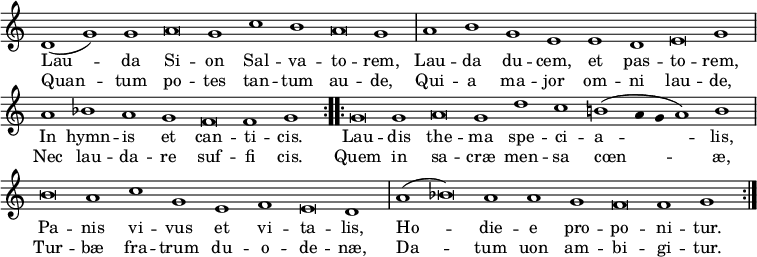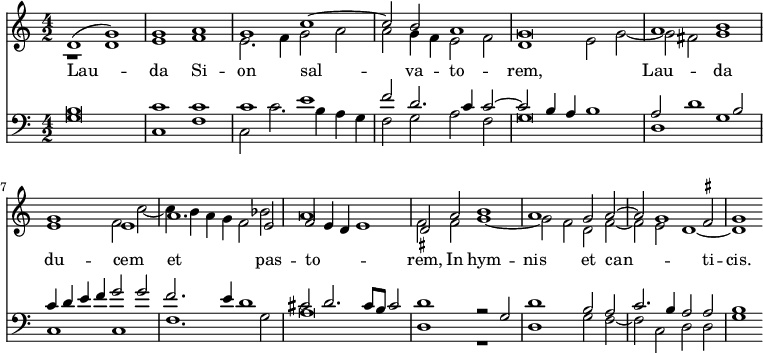A Dictionary of Music and Musicians/Lauda Sion
LAUDA SION. The name of a Sequence, sung, at High Mass, on the Feast of Corpus Christi, between the Gradual—Oculi omnium—and the Gospel for the Day. [See Sequentia.]
The text of the Lauda Sion, written, about the year 1261 [App. p.698 "1264"], by S. Thomas Aquinas, has always been regarded as a masterpiece of mediæval scholarship; and differs, in at least one very important point, from the four other Sequences still retained in use by the Roman Church. Not only does the rhythmic swing of its rhymed Trochaic Dimeters—strengthened by the introduction of a large proportion of Spondees—stamp it, at once, with the character of a glorious Hymn of Praise; but it serves, also, as a vehicle for the exposition of some of the most abstruse problems of dogmatic Theology, which are everywhere defined with an exactness as close as that shown in the statements of the 'Athanasian Creed.' And, strange to say, some of the verses which exhibit this lucidity of definition in the most marked degree, are precisely those in which the swing of the metre seems least encumbered by extraneous trammels. [See Metre; Prose. [App. p699 "for Prose read Sequentia."]]
This jubilant swing is finely brought out by the Plain Chaunt to which the Sequence is adapted—a fiery Melody, in Modes VII and VIII combined, exhibiting considerable variety of treatment and expression, and, in all probability, coæval with the text of the Sequence itself. Several readings of this Melody are extant, all agreeing in general contour, though differing in a few unimportant details. The purest version is probably that revised by the editors of the new Ratisbon Gradual; though the Mechlin form contains some passages which are, at least, entitled to careful consideration, more especially those in which the necessity for the introduction of a B♭ is avoided by a ligature extending to C.

The entire Melody is divided, like the portion we have selected as our example, into short strains, consisting of three, or more lines, according to the requirements of the metre: and the whole concludes with an Amen. Alleluia, of unusual beauty.
The poetry of the Lauda Sion has been many times subjected to polyphonic treatment of a very high order. Palestrina has left us two settings of the Sequence for eight voices, arranged in a double Choir, and a shorter one for four. The first, and best known, was printed, in 1575, by Alex. Gardanus, in the Third Book of Motets for 5, 6, and 8 Voices; and is one of the earliest examples of that peculiar combination of two Choirs, consisting of unequally balanced Voices, which Palestrina has made so justly famous—the Voices selected being, in this case, Cantus I and II, Altus, and Bassus, in the first Choir, and Altus, Tenor I and II, and Bassus, in the second. Its style is, in many respects, analogous to that of the celebrated Stabat Mater. As in that great work, several of the verses—from Bone Pastor, to In terra viventium, inclusive—are written in Triple Measure. But—as may be seen from the following example—the Lauda Sion is also remarkable for its close adherence, as a general rule, to the Plain Chaunt Melody.

A reprint of this beautiful composition will be found in vol. iii. of the complete edition of Palestrina's works now in course of publication by Messrs. Breitkopf & Härtel of Leipzig. The other 8-part setting, in Triple Measure throughout, hitherto known only through the medium of a MS. in the Library of the Collegio Romano, at Rome, has been recently published in vol. vii. of the same series.
Mendelssohn has also chosen the text of the Lauda Sion as the framework of a delightful Cantata, for four Solo Voices, Chorus, and Orchestra, composed in 1846, and first performed, in that year, at Liege, on the Feast of Corpus Christi (June 11. Though less elaborate in form than the 'Lobgesang' and some of its fellow cantatas, this fine production is strikingly characteristic of its author's best style. It would be difficult to find a happier example of his treatment of the Arioso than that exhibited in Caro cibus. In Sit laus plena every phrase dictated by the Soprano solo is immediately repeated in chorus, in a way which forcibly reminds us of the well-known movement, 'The enemy shouteth,' from 'Hear my prayer.' In Docti sacris, a fragment of the Plain Chaunt is treated after the manner of a Chorale,—but changed from the Eighth into the Tenth Mode, and, therefore, invested with a totally new character. In Sumit unus the dramatic element is introduced, with almost startling effect: and the whole concludes with a noble Chorus, adapted to the words Bone Pastor, and the concluding verses of the Hymn. The student will find it interesting to compare this essentially modern adaptation of the text with the purely ecclesiastical treatment adopted by Palestrina.